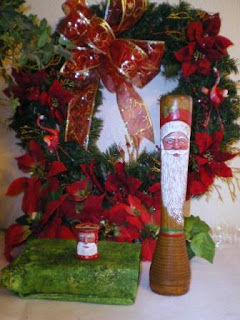Bill and I wish all are family and friends a very wonderful Christmas and the best in the coming new year. We have been so fortunate to have all of you in our lives.
May the coming new year bring you wonderful surprises, connections with family and friends, and the best that life can offer.
Roseburg has a great little art gallery filled with our local artists' talent. The two Santa's were found there this week. The artist who carved them is Jani Brown. Each piece has a special meaning to me. The large thread spindle because my Polish Grandmother (Babci) use to work in the thread mill in Norwich, Conn. That was how she supported a family of six children.
The smaller wooden spool because I sew and this is one of the few wooden spools I have seen. I thought it was a fantastic fine until I researched it. The J&P Coats Company and the Clark Thread Company merged in 1959. This makes me older than the wooden spool. Isn't that a sorry thought!
If you are really interested in some of the history of thread then you might enjoy the following:
History of Coats & Clark
With a rich heritage dating back to the early 1800's, Coats history is interwoven with many key innovations and historic events dating back to the beginnings of the industrial revolution. With nearly 200 years of history to share, we have selected a few interesting facts and images from our archives that we thought you would enjoy. | |  |
| |
|
|
|
|
| interesting facts |
| |
| 1806 — Napoleon blockaded Great Britain, making silk no longer available to weavers who had begun reproducing the rare Kashmir shawls of India. At the time, the Clark family had a thriving loom equipment business, and sold silk threads for the warp on the looms.
It was at this time that Patrick Clark developed a method of twisting cotton yarns together to produce a thread which was so strong and smooth that it could replace silk in the looms, as well as replace linen and silk threads used for hand sewing as well.
1812 — The Clarks opened the first factory for making cotton sewing thread in Paisley, Scotland. A few years later, another cotton thread mill was opened by James Coats.
1830 — The sons, James and Peter Coats, purchased their fathers' mill, and within a decade, J&P Coats Limited had expanded, with much of its production exported to America. Another member of the family, Andrew Coats, was sent to the U.S. to manage the business.
1864 — George and William Clark, grandsons of James Clark, opened a cotton thread mill in Newark, New Jersey. Five years later, the Coats family began manufacturing thread in Pawtucket, Rhode Island, selling under the name "Spool Cotton Company".
Before Elias Howe's invention of the sewing machine in 1846, thread was usually made of three cords and was used for hand sewing. The thread had a glazed finish and was too wiry and uneven for machine use.
Twenty years later, George Clark developed a six-cord, soft finished thread. This thread, the first ever suitable for machine use, revolutionized the sewing industry, and therefore he called it "Our New Thread." This became known as O.N.T., originating the still famous trademark for the Clark Thread Company product.
1896 — The company continued to grow by adding new products and innovations, including crochet, darning, knitting and embroidery cottons. O.N.T. was the first genuinely fast black thread and the first American brand of sewing, crochet and embroidery cotton to be offered in a large range of colors, all color fast to boiling.
1935 — Prior to 1935, Coats & Clark companies in the United States sold a wide range of cotton threads and handicraft products but no wool yarns. An agreement was reached with Patons & Baldwins, a British manufacturer of knitting yarns, to make yarn in the United States which would be marketed through the Spool Cotton Company.
1952 — J. & P. Coats and the Clark Thread Co. merged to become Coats & Clark Inc.
1959 — Two important innovations were developed, starting with our first 100% acrylic yarn in 1959, followed by the release of Super Saver 'no-dye-lot' yarn in 1987.
1960's — Coats & Clark created cotton-covered polyester core thread which combined the best characteristics of both fibers making it compatible with new fibers and fabrics which had entered the market. Today, Coats Dual Duty Plus® is the number one selling all purpose thread in the home sewing market.
Today, Coats world-wide continues to innovate. Through ongoing research and product development, we explore new fibers, fabrics, finishes and their application for consumer and industrial applications.
Merry Christmas and a Happy New Year ! |
|
|
|

No comments:
Post a Comment